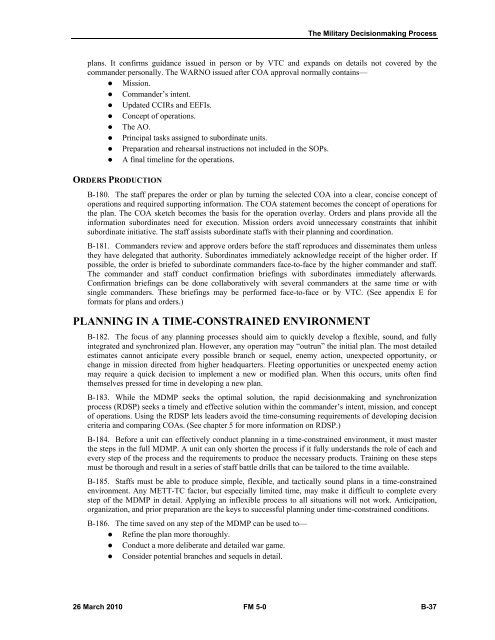FM 5-0, The Operations Process - Federation of American Scientists
FM 5-0, The Operations Process - Federation of American Scientists
FM 5-0, The Operations Process - Federation of American Scientists
You also want an ePaper? Increase the reach of your titles
YUMPU automatically turns print PDFs into web optimized ePapers that Google loves.
<strong>The</strong> Military Decisionmaking <strong>Process</strong><br />
plans. It confirms guidance issued in person or by VTC and expands on details not covered by the<br />
commander personally. <strong>The</strong> WARNO issued after COA approval normally contains—<br />
• Mission.<br />
• Commander’s intent.<br />
• Updated CCIRs and EEFIs.<br />
• Concept <strong>of</strong> operations.<br />
• <strong>The</strong> AO.<br />
• Principal tasks assigned to subordinate units.<br />
• Preparation and rehearsal instructions not included in the SOPs.<br />
• A final timeline for the operations.<br />
ORDERS PRODUCTION<br />
B-180. <strong>The</strong> staff prepares the order or plan by turning the selected COA into a clear, concise concept <strong>of</strong><br />
operations and required supporting information. <strong>The</strong> COA statement becomes the concept <strong>of</strong> operations for<br />
the plan. <strong>The</strong> COA sketch becomes the basis for the operation overlay. Orders and plans provide all the<br />
information subordinates need for execution. Mission orders avoid unnecessary constraints that inhibit<br />
subordinate initiative. <strong>The</strong> staff assists subordinate staffs with their planning and coordination.<br />
B-181. Commanders review and approve orders before the staff reproduces and disseminates them unless<br />
they have delegated that authority. Subordinates immediately acknowledge receipt <strong>of</strong> the higher order. If<br />
possible, the order is briefed to subordinate commanders face-to-face by the higher commander and staff.<br />
<strong>The</strong> commander and staff conduct confirmation briefings with subordinates immediately afterwards.<br />
Confirmation briefings can be done collaboratively with several commanders at the same time or with<br />
single commanders. <strong>The</strong>se briefings may be performed face-to-face or by VTC. (See appendix E for<br />
formats for plans and orders.)<br />
PLANNING IN A TIME-CONSTRAINED ENVIRONMENT<br />
B-182. <strong>The</strong> focus <strong>of</strong> any planning processes should aim to quickly develop a flexible, sound, and fully<br />
integrated and synchronized plan. However, any operation may “outrun” the initial plan. <strong>The</strong> most detailed<br />
estimates cannot anticipate every possible branch or sequel, enemy action, unexpected opportunity, or<br />
change in mission directed from higher headquarters. Fleeting opportunities or unexpected enemy action<br />
may require a quick decision to implement a new or modified plan. When this occurs, units <strong>of</strong>ten find<br />
themselves pressed for time in developing a new plan.<br />
B-183. While the MDMP seeks the optimal solution, the rapid decisionmaking and synchronization<br />
process (RDSP) seeks a timely and effective solution within the commander’s intent, mission, and concept<br />
<strong>of</strong> operations. Using the RDSP lets leaders avoid the time-consuming requirements <strong>of</strong> developing decision<br />
criteria and comparing COAs. (See chapter 5 for more information on RDSP.)<br />
B-184. Before a unit can effectively conduct planning in a time-constrained environment, it must master<br />
the steps in the full MDMP. A unit can only shorten the process if it fully understands the role <strong>of</strong> each and<br />
every step <strong>of</strong> the process and the requirements to produce the necessary products. Training on these steps<br />
must be thorough and result in a series <strong>of</strong> staff battle drills that can be tailored to the time available.<br />
B-185. Staffs must be able to produce simple, flexible, and tactically sound plans in a time-constrained<br />
environment. Any METT-TC factor, but especially limited time, may make it difficult to complete every<br />
step <strong>of</strong> the MDMP in detail. Applying an inflexible process to all situations will not work. Anticipation,<br />
organization, and prior preparation are the keys to successful planning under time-constrained conditions.<br />
B-186. <strong>The</strong> time saved on any step <strong>of</strong> the MDMP can be used to—<br />
• Refine the plan more thoroughly.<br />
• Conduct a more deliberate and detailed war game.<br />
• Consider potential branches and sequels in detail.<br />
26 March 2010 <strong>FM</strong> 5-0 B-37















